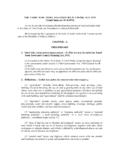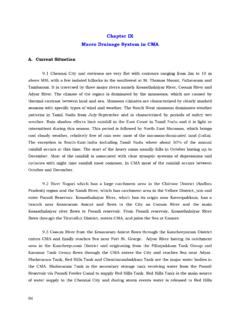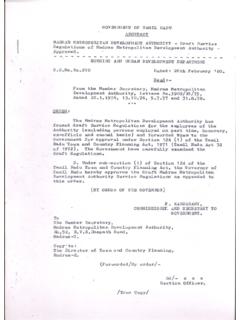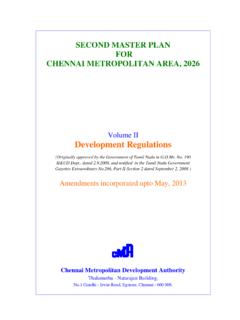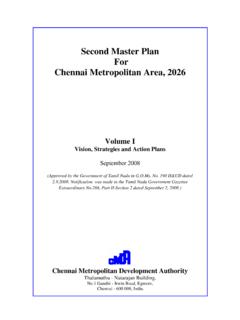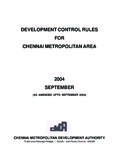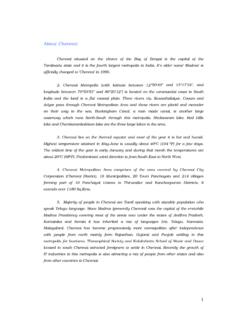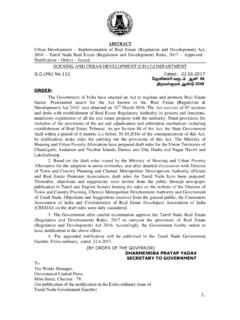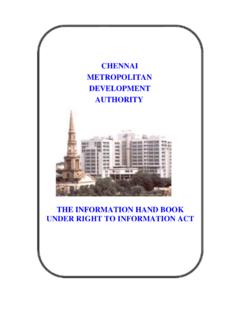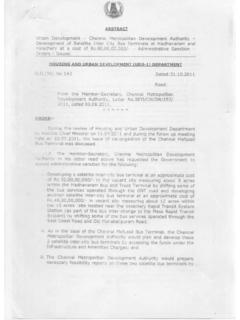Transcription of Chapter XIV LAND USE AND PLANNING STRATEGY
1 286 Chapter XIV LAND USE AND PLANNING STRATEGY With the increase and concentration of population in urban areas, urban problems have increased. It requires and continues to require restriction in respect of the use and occupation of land in urban areas. In order to regulate the growth of the metropolitan area in an orderly manner and also to ensure its economic viability, social stability and sound management for the present and the foreseeable future, the Master Plan with zoning and development regulation is necessary. The idea of zoning is that the segregation of certain uses from others reduces the effect of negative externalities, which some uses have on others. Zoning provides spatial segregation of conflicting uses. It also has the benefit of increasing positive externalities because many uses find an advantage in being grouped with other similar uses.
2 These external effects include air and water pollution, excessive noise levels, traffic congestion, and aesthetic disamenities. Because of its predominant role, modern zoning encompasses expanded objectives for supplying certain public goods such as preservation of open space, prime agriculture land and ecologically sensitive areas also. Zoning is also desired on reduction of costs of providing certain public services. Land use regulation in CMA prior to 1975: Land use control in CMA prior to 1975 was not significant. Only about 20% of the Chennai City area, and less than 1% of the remaining CMA area (outside the city) were covered by the Detailed Town PLANNING Schemes prepared under the (now repealed) Madras State Town PLANNING Act, 1920. Under Section 89, of the Tamil Nadu Public Health Act, 1939 City Corporation of Madras and some of the Municipalities in CMA had declared residential areas (covering very small part of the local bodies concerned) and in such areas industries other than cottage industries were not permitted; shopping (except offensive trades) were not prohibited provided they did not use power.
3 Industrial areas were declared under the Municipal Acts where industries existed then, and on individual application further industrial areas notified/expanded. These minimal land use regulations existed then orienting more towards preserving the then existed areas rather than channelsing the developments optimising the land and other resources in a planned way. 287 Land sub-division regulations prior to 1975 in CMA were limited to the control of making public and private streets under the local body Acts and they were not framed either to discourage such developments in such areas where it is not suitable or divert them to the areas where suitable; further they did not provide for necessary standards statutorily for roads, open spaces and other essential infrastructure. Land use regulation under Master Plan for CMA, 1975: The Master Plan for Chennai Metropolitan Area come into force from from the date of notification of the Government consent for the plan (in Ms.)
4 , RD&LA Dept. dated ); it was finally approved by the Government in Ms. , RD&LA Department, dated The Master Plan laid down policies and programmes for the overall development of the CMA. The land use plan designated the use to which every parcel of land in CMA could be put to. The land use plan was enforced through a set of regulations under Development Control Rules, which formed part of the master plan. Any person intending to make any development is required to apply under Section 49 of the Tamil Nadu Town and Country PLANNING Act, 1971, and obtain PLANNING Permission. The break up of the then existed Land Use in 1973 is given in the Table below: CMA - Existed Land Use - 1973 Chennai City Rest of CMA Total Land use Extent in Hect. % Extent in Hect. % Extent in Hect. % Residential 7788 9144 16932 Commercial 820 68 888 Industrial 893 2976 3869 Institutional 3045 2260 5305 Open space and Recreational 920 4822 5742 Agriculture 73689 73689 Non Urban 1633 1633 Others 4052 10865 14917 Total 17518 100 105456 122974 The land use zoning classifications as per the First Master Plan for CMA are (i) Primary Residential Use zone, (ii) Mixed Residential Use zone, (iii) Commercial use Zone, (iv) Light Industrial use zone, (v) General Industrial use zone, (vi) Special and Hazardous 288 Industrial use zone, (vii) Institutional use zone, (viii)
5 Open Space and Recreational Use zone, (ix) Agriculture use zone and (x) Non-urban use zone. Further considering the character of (then) existed developments, the CMA was divided into three areas viz. (i) George Town and Continuous Building Area, (ii) Chennai City, Municipal and Township areas (excluding the areas mentioned in (i)) and (iii) rest of Metropolitan area. The break up of the land use proposed in the First Master Plan (1975) is given in the table below: Land use proposed as per First Master Plan Chennai City Rest of CMA Total Land use Extent in Hectares % Extent in Hectares % Extent in Hectares % Primary Residential Mixed Residential Commercial Institutional Light Industrial General Industrial Special & Hazardous Industrial Open space & Recreational Agricultural Non Urban Others (Forest, water bodies, Roads etc.)
6 ,) Total A few problems were faced in implementing the first Master Plan zoning and DCR; the major ones are given below: (1) In certain areas where a site has been zoned for two or more uses (with reference to the abutting road and adjoining uses) an optimal development of single character could not be made taking into account the total extent of the site; (2) In certain cases, though the existing activities and their performances are not hazardous or objectionable, they could not be allowed to expand even marginally because the zoning made in the Plan is not conforming to accommodate such activities; 289(3) Sites zoned for public purposes such as open space and recreational use zone, institutional use zone, stand designated throughout the Plan period and the activities permissible in these zones are public/communal facilities mostly for which the Government/or Government agencies have to acquire and provide.
7 Neither the PLANNING authorities nor the Government or its agencies have acquired these lands and provided these facilities. (The reasons may be paucity of funds. Such zoning could have been restricted to mainly on Government lands, and to the private lands where this activity exist, or essentially required to be acquired for providing the same); (4) Grouping of permissible activities made in zones such as institutions, open space and recreation are such that these appear so exclusionary, not even permitting residential activity, which is a lower use which a land owner/developer may like to put to at least. Such zoning could have been minimised in the midst of contiguous developed areas; (5) According to the existing procedure, rezoning (land use variation) consumes a lot of time, with the result discouraged people to apply and get the site reclassified; (6) Same way, Urban Land Ceiling Act (now repealed) had contributed to unauthorised sub divisions/layouts; (7) The present zoning and DCR is criticised by a section of developers, for being negative rather than positive; it is more oriented towards the provision of safety, convenience and tranquility in the area rather than encouragement of housing activity, industries and employment; (8) The standards set for plot extent; frontage etc.
8 , for residential developments was high when comparing the affordability of people even for middle-income group of the society. Reclassification: Reclassification of land uses on request from the land owners are received, examined and decided on individual merits of the cases under Section 32(4) of the Tamil Nadu Town and Country PLANNING Act. From 1976 to 1981, there were about 100 land use reclassifications within CMA, mostly in the areas of sanctioned Town PLANNING Schemes approved prior to 1975. The number of reclassifications made year wise within City and rest of CMA are tabulated below: 290 Table No. : Reclassifications within City and Rest of CMA, 1977-2004 Year City Municipality Town Panchayat Panchayat Union Total 1. 1977 2 4 -- -- 6 2.
9 1978 1 1 -- -- 2 3. 1979 -- -- 1 -- 1 4. 1980 -- 6 4 3 13 5. 1981 -- -- -- -- -- 6. 1982 17 13 11 20 61 7. 1983 11 9 5 10 35 8. 1984 23 8 55 36 122 9.
10 1985 44 5 12 29 90 10. 1986 18 5 16 19 58 11. 1987 17 4 8 14 43 12. 1988 14 5 14 64 97 13. 1989 2 1 2 13 18 14. 1990 27 3 19 56 105 15. 1991 30 11 11 59 111 16. 1992 17 11 9 42 79 17.
